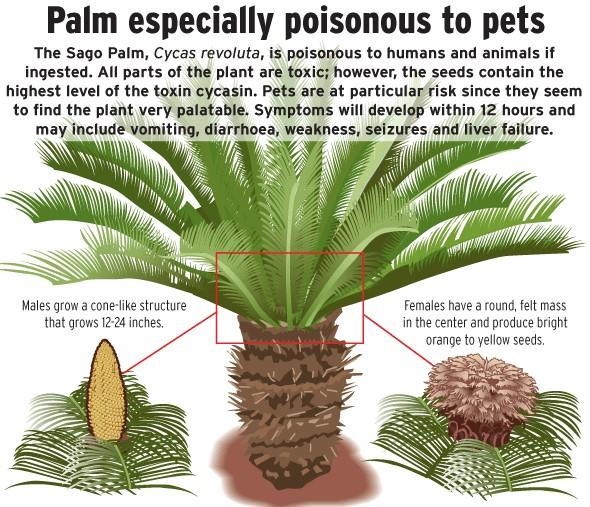
- posted: Feb. 10, 2017
A hidden danger may be lurking in your landscaping. The Sago Palm (generaCycads Macrozamia, and Zamia) is a common ornamental plant that grows in tropical and subtropical environments such as Hawaii and the Southern United States. Plants from this family include Cycad (Cycas cirinalis), cardboard palm (Zamica furfuracea), Japanese cycad (Cycas revoluta) and Coontie (Zamia pumila). It is sold as both an indoor ornamental and as a landscaping plant. All parts of the plant are poisonous, but the seeds and nuts are the most dangerous.
Toxins of the Sago Palm affect the digestive tract, liver and nerves. Signs of poisoning start anywhere from 15 minutes to several hours after ingestion. Typically you will see intestinal signs first - loss of appetite, drooling, vomiting and diarrhea. Within 2 to 3 days, liver damage causes more vomiting and diarrhea, yellow coloring of the whites of the eyes and skin, bloody or dark, tarry stool and disorientation or head pressing. Neurologic symptoms include weakness, staggering, trembling and seizures. Once the liver and nervous system are affected, the problem has become very serious. Statistics show that up to 1/3 to 1/2 of poisoned animals may not recover at this stage.
The best advice is to remove any Sago palms and any fallen parts of the plant from your house and yard. If you see your dog eating any part of a Sago palm, immediately take you pet to your veterinarian to induce vomiting. If you cannot get to a veterinarian quickly, you can induce vomiting by give 1 teaspoon of hydrogen peroxide per 5 pounds of body weight - not to exceed 3 tablespoons total in large dogs. As soon as possible, take your pet to your veterinarian or an emergency veterinary facility for further decontamination procedures, tests and supportive care as needed.
Sago Palms are just one of many poisonous plants that are commonly used in landscaping. Many common landscape plants can be dangerous, especially if you have curious puppies or kittens or “chow hounds”. Others in the top ten list include:
Lilies: some, such as Peace, Calla and Peruvian lilies only cause minot skin, mouth and throat irritation. Others such Asa Tiger, Day, Asiatic, Eastern and Japanese Show Lilies cause severe, often fatal kidney failure in cats.
Kalanchoe: vomiting, diarrhea and irregular heart beat
Oleander: severe vomiting, heart problems and even death
Dieffenbachia: intense oral irritation, drooling, vomiting and difficulty swallowing
Daffodils: severe vomiting diarrhea, abdominal pain - in severe cases irregular heart beat and trouble breathing
Autumn Crocus: vomiting, intestinal bleeding, liver and kidney damage and respiratory failure
Azalea: vomiting, diarrhea, drooling and sometimes coma and death
Cyclamen: vomiting, death in severe cases.
Lily of the Valley: vomiting, diarrhea and slow or irregular heart beat and seizures.
Tulip and Hyacinth bulbs: irritation of the mouth and throat.
For a more complete list of poisonous plants (and all poisons) see the Pet Poison Helpline website http://www.petpoisonhelpline.com/poisons/
